How the right lighting can improve safety for rail operators
July 2022
July 2022
KNOWLEDGE
The importance of lighting for safety in the rail sector should not be underestimated. Here, David Woodcock, our Business Unit Manager – Rail, looks at how the right integrated lighting solutions can improve safety.
There are a number of ways that lighting technologies can be used to improve the safety of railway stations, level crossings and other areas of the rail network. This ranges from minimising slips and trips to helping to prevent trespass on the line.
Safer station platforms
Perhaps the most obvious is ensuring that all areas of the station are illuminated appropriately to prevent slips, trips and falls. Lighting can also make people feel safer and more comfortable. A report by independent watchdog Transport Focus found that just 64% of passengers feel safe while travelling by rail after dark, compared to 98% during daylight hours.
The correct lighting scheme can deliver uniform levels of illumination along the platform, meaning that all objects and surfaces, including signage, platform edges and steps, as well as other people are clearly visible.
This must be achieved while preventing glare that may affect train drivers’ vision. This often requires a range of luminaires or optics to ensure the light is directed where needed. For example, on the refurbishment of Crediton Station in Devon our Kirium Pro column mounted luminaires were combined with our tough Kova wall mounted products and our Garda illuminated handrail.
|
|
|
David Woodcock, Rail Business Unit Manager Originally trained as an electrical engineer, David has over 25 years of experience within the lighting industry and has previously worked at DW Windsor in a number of key roles. As Rail Business Unit Manager, he helps to provide lighting and control-based solutions within the transportation sector. |

There are over 6,000 level crossings across the rail network with many different types, both manned and unmanned. The reality is that these are often the most accessible areas of the network for those attempting to trespass on the line. Good illumination not only minimises the risk of trips and falls for people crossing but also discourages trespass as it increases the perception that they will be seen by localised CCTV and relevant authorities notified.
However, if someone does access the track at a level crossing, it is essential to detect this to prevent crime and avoid collisions between trains and pedestrians. Technologies such as Light Imaging Detection and Ranging (LIDAR) and Infrared (IR) cameras can provide warnings of people on the line. Integrating these devices into the luminaires installed around crossings is an ideal solution.
While LIDAR has been utilised for obstacle detection at around 100 crossings across the country, the latest generation of the technology has enhanced capabilities and allows the system to be deployed at a much wider range of crossings. The proposed schemes we are currently working on with clients will be able to detect people further up the line from the crossing and provide early warning to operators of the danger. If necessary, trains can be slowed or held to prevent collisions.
However, not all instances of near misses and collisions at level crossings result from intentional trespass. Sometimes people can be distracted, such as when looking at a mobile phone, or not hear the warnings that the barriers are coming down. LED lighting integrated at ground level can provide an additional warning for people that do not see the main signal lights.
Addressing suicide
The sad fact is that vulnerable people sometimes use the railway to end their own life. It is often difficult to identify someone who is considering suicide as there is no one type of person more likely to be in that situation. However, there are certain patterns of behaviour that may provide clues to their intentions and allow intervention to be made. For example, their movement and behaviour on the platform as well as where they choose to stand may provide an indication.
Lighting solutions on station platforms can be used to both help identify those that may be in danger and attempt to provide an intervention. Sophisticated sensors can be integrated into the luminaires to anonymously track the position and movement of people in key areas of the platform. If a person is behaving in a way that matches the identified behaviours, the system can alert station staff, direct and encourage them to use the ‘Help’ point and also adjust the lighting to try to influence them. The lighting around them can also be adjusted to make them feel like they are being seen, which may discourage them from their intended course of action. Switching the lighting colour to blue has been trialled because studies carried out in Japan suggest that this colour may be effective in this situation.

Alerting the station staff allows them to gently intervene. Since 2010, Samaritans have trained more than 28,000 rail staff to ensure they have the skills required to help someone at risk of suicide. It is estimated that this has resulted in more than 900 potentially life-saving interventions. The exact number may be even higher as not every intervention is recorded. The charity’s Small Talk Saves Lives’ campaign is based on the idea that something as simple as asking a person a question or engaging them in conversation can be enough to make a difference. Therefore, identifying those in need quickly can help to save lives.
To conclude, correct and effective lighting is essential for safety and integrating advanced technology into the luminaires can provide easy recognition of trespass, hazards and those who may be at risk.